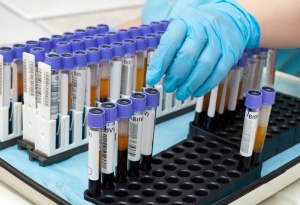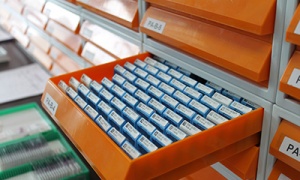Difference between revisions of "Biobanking"
(Added preliminary ethical info) |
|||
| Line 32: | Line 32: | ||
1.) Virtual Biobanks -- these are storehouses for digital information that has been accumulated and uploaded from a variety of researchers (or institutions) and their projects. | 1.) Virtual Biobanks -- these are storehouses for digital information that has been accumulated and uploaded from a variety of researchers (or institutions) and their projects. | ||
| − | + | [[File:Ourbiospecimens1.jpg|thumb|right|300px|Example of Tissue Biobank]] | |
2.) Tissue Banks -- these are storehouses for biological samples, which harvest and store human and animal tissue samples for transplantation and research. | 2.) Tissue Banks -- these are storehouses for biological samples, which harvest and store human and animal tissue samples for transplantation and research. | ||
Revision as of 20:33, 26 April 2016
Biobanking is a form of biological storage, used in research settings. From the 1990s onwards, biobanks have become instrumental in medical research, particularly in the fields of genomics and personalized medicine.
Biobanks allow researchers to collect and analyze vast quantities of data. The samples and data collected by biobanks are often used by researchers in multiple projects and settings, most significantly cross-purpose studies, often for the purposes of fighting and understanding diseases and how they are spread. Prior to the advent of biobanks, acquiring samples for these purposes was much harder than it is now.
Ethically, biobanks have raised questions on privacy, research ethics, and medical ethics. While viewpoints on these ethics are varied, the general consensus is that strong ethical guidelines and policies are needed for the purposes of operating a biobank, as failing to do so can be detrimental to biobanks themselves, as well populations that allow biobanks to open in their local communities.
Contents
History
Before the 1990s, scientists and researchers would themselves have to collect biological samples for each experiment they did. There was no unified system of sharing that was readily available to them. The effects of this could most easily be seen in the field of genetics, where scientists relied on prior research of a given sample to inform them of what areas to explore or tests to conduct regarding their own unique samples.
Eventually, this changed due to the realization that while diseases and disorders have genetic component, very few of them owe their manifestation to a single defective gene -- rather, they are caused by multiple genetic factors occurring on a multitude of different genes. As a result of this discovery, it was realized that it was necessary to perform genome-wide scans of a given biological sample vs the one-off genetic analysis of individual genes.
Around the time that this was happening, technological advances made it possible for the mass sharing of information. Thus, when data was collected, scientists doing genetic analysis found that they could coordinate their research efforts and have their work contribute to a larger body of knowledge in the field of genetics itself, thus allowing researchers the world over to access information derived from each other's work. Where before, genetics research was originally limited to a single laboratory or institution, now it was placed into unified and networked databases that the scientific community could access instantaneously with nothing more than an internet connection and computer. These were the world's first biobanks.
The development of these biobanks was far reaching. The sharing of the data derived from widespread sharing of genome-wide scanning led to the discovery of many single-nucleotide polymorphisms -- basically genetic variants. Indeed, in the ten years following the implementation of genome wide scans and the biobanking system, the number of discovered polymorphisms increased by a factor of fifty.
However, this didn't solve every problem. The first biobanks were storehouses for genetic information and research results. Another important area for biological research though, was that of phenotypic data. While genetic data can be gathered through a blood, saliva, or other biological sample, phenotypic data has to be collected through physical observation and examination of the subject that a given genetic sample can be derived from. This data includes information derived from interviews, physical assessment, review of medical history, or any other source of data that cannot be derived solely from a subject's genetic material.
Moreover, due to the nature of how phenotypic data is gathered, there were (and are) ethical considerations as to the rights of the subjects that data is derived from. These considerations became especially pertinent as biobanks began collecting phenotypic data and connecting it to genotypic data for the purposes of research and data sharing among scientists and institutions.[1]
By the late 2000s, scientists had stored more than two hundred and seventy million biological samples and specimens in biobanks in the United States alone, and had collection rate of twenty million new samples additions per year. However, this is a trend that goes outside the United States, and are reflective of similar setups around the globe. The development of this massive catelog of biological samples has lead to a massive paradigm shift in the way genetic research data is shared, as there has never before been a time in history when scientists in this field have had access to such a massive number of samples and data.
This access has not been without controversy however, and some of the challenges raised by the rise of biobanks have included: the fairness of collecting sample donations and data from vulnerable populations, providing informed consent to donors, the logistics of data disclosure to participants, the right to ownership of intellectual property, and the privacy and security of donors who participate. Because of these issues, researchers and policy makers began to require new systems of research governance.[2]
Types of Biobanks
The term "biobank" has connotated different meanings since its initial inception. Currently, the most widely used description is as "an organized collection of ... biological material and associated information stored for one or more research purposes". Collections of plant, animal, microbe, and other nonhuman materials can be included in the definition of a biobank, or it can refer exclusively to human-derived samples.[3]
Biobanks usually incorporate cryogenic storage mechanisms and facilities for their samples. These may range in size from individual refridgerators to entire warehouses, and are usually maintained by institutions such as hospitals, universities, nonprofit organizations, and pharmaceutical companies.[4]
In general, biobanks can be classified by their purpose or design. Disease-oriented biobanks usually have a hospital affiliation through which they collect samples representing a variety of diseases.[5] Population-based biobanks need no particular hospital affiliation because they take samples from large numbers of all kinds of people.[6] Most often, biobanks derive their samples and information from one or more of the following three institutions:[7]
1.) Virtual Biobanks -- these are storehouses for digital information that has been accumulated and uploaded from a variety of researchers (or institutions) and their projects.
2.) Tissue Banks -- these are storehouses for biological samples, which harvest and store human and animal tissue samples for transplantation and research.
3.) Population Banks -- these store biomaterial that is correlated with associated characteristics such as lifestyle, clinical and environmental data.
Ethics of Biobanking
There are many ethical considerations to biobanking. Most of the time, these arise due to a key cornerstone of biobanking itself: namely, when a researcher wants to collect a specimen for research. When this occurs, some of the major issues revolve around the following: right to privacy for research participants, ownership of the specimen and its derived data, the extent to which the donor can share in the return of the research results, and the extent to which a donor is able to consent to be in a research study. [8]
Regarding consent, the issues revolve around the fact that biobanks usually collect samples and data for the purposes of current and future research. As a result, it is unfeasable to obtain consent for every research instance that the sample or data may be used in. Within this context, broad spectrum consent forms have been discussed and utilized in various biobank and research settings. However, these consent forms have come under scrutiny, as they may not ultimately satisfy ethical and legal requirements. [9]
Privacy for Research Participants
Ownership of Specimens
Return of Results
Informed Consent
References
- ↑ Greely, H. T. (2007). "The Uneasy Ethical and Legal Underpinnings of Large-Scale Genomic Biobanks". Annual Review of Genomics and Human Genetics 8: 343–364. doi:10.1146/annurev.genom.7.080505.115721. PMID 17550341.
- ↑ Haga, S.; Beskow, L. (2008). "Ethical, Legal, and Social Implications of Biobanks for Genetics Research". Genetic Dissection of Complex Traits. Advances in Genetics 60. pp. 505–544. doi:10.1016/S0065-2660(07)00418-X. ISBN 9780123738837. PMID 18358331.
- ↑ Hewitt, R. E. (2011). "Biobanking: The foundation of personalized medicine". Current Opinion in Oncology 23 (1): 112–119. doi:10.1097/CCO.0b013e32834161b8. PMID 21076300.
- ↑ Silberman, Steve (June 2010). "The Flesh Files". Wired 18 (6): 157–161, 182, 184, 188, 190.
- ↑ Bevilacqua, G.; Bosman, F.; Dassesse, T.; Höfler, H.; Janin, A.; Langer, R.; Larsimont, D.; Morente, M. M.; Riegman, P.; Schirmacher, P.; Stanta, G.; Zatloukal, K.; Caboux, E.; Hainaut, P. (2010). "The role of the pathologist in tissue banking: European Consensus Expert Group Report". Virchows Archiv 456 (4): 449–454. doi:10.1007/s00428-010-0887-7. PMC 2852521. PMID 20157825.
- ↑ Riegman, P. H. J.; Morente, M. M.; Betsou, F.; De Blasio, P.; Geary, P.; Marble Arch International Working Group on Biobanking for Biomedical Research (2008). "Biobanking for better healthcare". Molecular Oncology 2 (3): 213–222. doi:10.1016/j.molonc.2008.07.004. PMID 19383342.
- ↑ Labant, MaryAnn (Jan 15, 2012). "Biobank Diversity Facilitates Drug & Diagnostic Development". Genetic Engineering & Biotechnology News 32 (2): 42,44. doi:10.1089/gen.32.2.21. ISSN 1935-472X. Retrieved 1 February 2012.
- ↑ Hawkins, Alice K.; Kieran C. O'Doherty (7 October 2011). ""Who owns your poop?": insights regarding the intersection of human microbiome research and the ELSI aspects of biobanking and related studies". BMC Medical Genomics 4: 72. doi:10.1186/1755-8794-4-72. PMC 3199231. PMID 21982589.
- ↑ Hoeyer K. Trading in Cold Blood? Trust in Biobanking 2012; 21-41.

